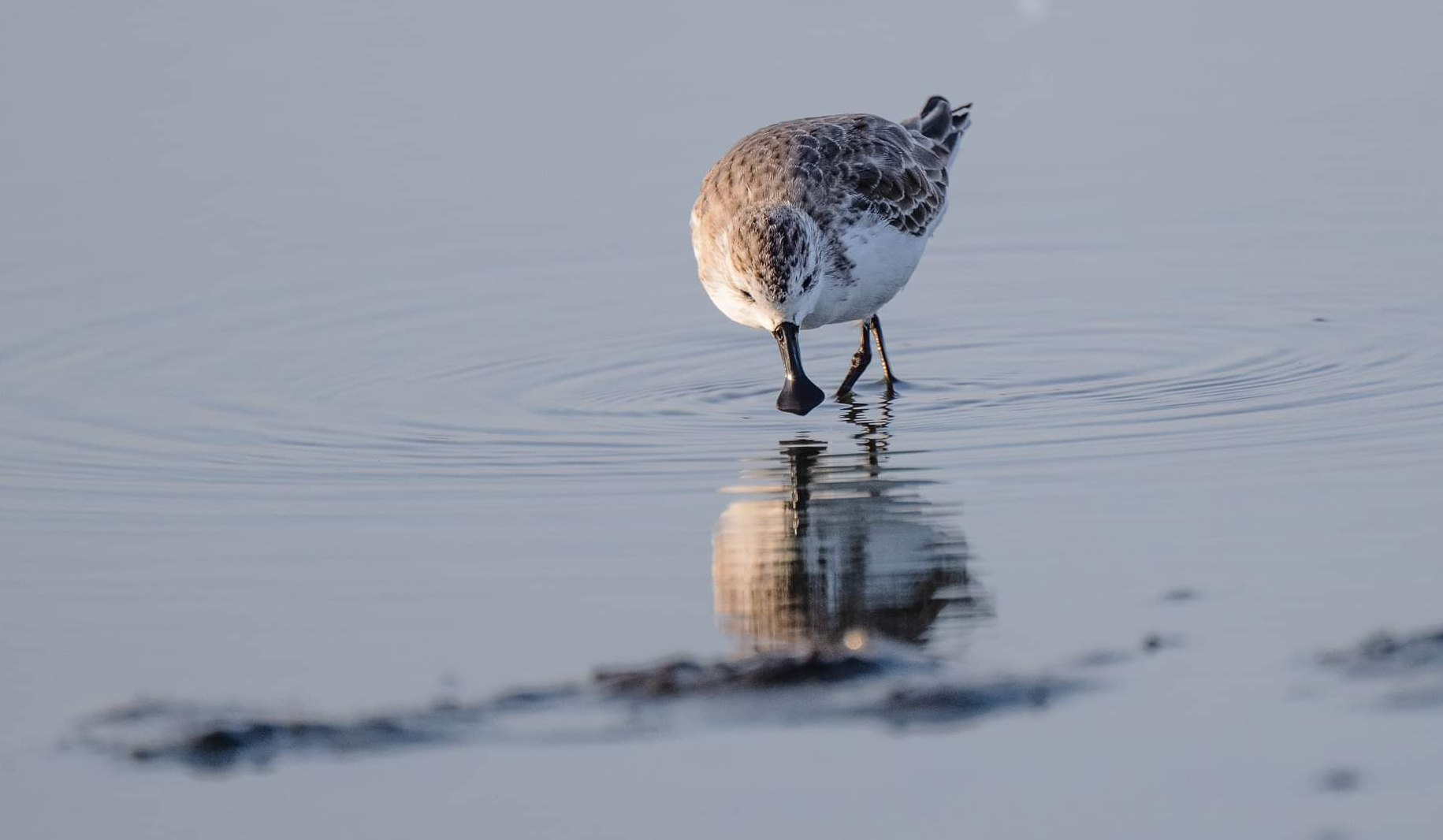
Spoon-billed Sandpiper, Thailand by Phattharadech Thananphitchayakon
Tour Dates: Saturday 4th – Sunday 19th January 2025 (Bangkok to Bangkok)
Tour Price: £3,499pp plus flights
Estimated International Flight Price: London to Bangkok approx. £700 return
Estimated Internal flight Mai Chang to Bangkok: £100
Deposit: £500 per person
Conservation Donation from Wise Birding: £150 – £200
Minimum Number: 4 people
Maximum Group Size: 6 people
Target Birds:
Great Hornbill, Wreathed Hornbill, Tickell’s Brown Hornbill, Siamese Fireback, Silver Pheasant, Mrs Hume’s Pheasant, Bar-backed Partridge, Mountain Bamboo Partridge, Spoon-billed Sandpiper, Nordmann’s Greenshank, Asian Dowitcher, Lesser Necklaced Laughingthrush, Greater necklaced Laughingthrush, Siberian Blue Robin, Blue Pitta, Green Magpie, Black-backed Kingfisher, Long-tailed Broadbill, Black and Yellow Broadbill, Silver-breasted Broadbill, Dusky Broadbill, Red-headed Trogon, Banded Kingfisher, Great Slaty Woodpecker, Blue-bearded Bee-eater, Ratchet-tailed Treepie, Giant Nuthatch, Himalayan Cutia, Crested Finchbill, Chestnut-headed Tesla, Slaty-bellied Tesia, Streaked Spiderhunter, Rufous Limestone Wren Babbler, Himalayan Shortwing, Pygmy Cupwing, Hume’s Treecreeper, Clicking Shrike Babbler, Yellow-cheeked Tit, Blyth’s Leaf Warbler and many more!
Target Mammals:
Dusky Langur, Lar Gibbon, Pig-tailed and Stump-tailed Macaques, Asian Elephant, Lesser Mouse Deer and a chance for Sun Bear and Leopard too!
Plus a good selection of Squirrel and other Deer species.
Tour Summary
This tour covers Central and North Thailand giving a fantastic introduction to many of the key families and iconic birds of South-East Asia.
We will focus on all the best birding sites of this bird rich country allowing us to see a fabulous and diverse selection of habitats and birds. Travelling from the Central region to the north by road rather than flying, allows us to add even more birding sites to the itinerary and to boost our bird list!
We start along the shoreline of the Inner Gulf of Thailand, one of the country’s largest salt production areas and an internationally important site for migratory shorebirds in the whole of South-East Asia. It is here at Khok-Kham Salt Pans where we should find one of the key birds of the trip; the iconic Spoon-billed Sandpiper as well as Nordmann’s Greenshank and a possibility of Asian Dowitcher too! The itinerary then moves to Kaeng Krachan National Park, in Petchaburi and Prachuab Kiri Khan provinces and the largest National Park in Thailand, occupying 2,915 square kilometres. It is often considered as one of Thailand’s premier forest birding sites and it is an excellent place to see a hugely impressive mix of species. In the lower elevations we will look for species such as Greater Necklaced Laughingthrush and Blue-bearded Bee-Eater in contrast to the tops of the mountains where we hope to find gems such as Ratchet-tailed Treepie, White-hooded Babbler, White-browed Shrike-Babbler, Red-headed Trogon and Streaked Spiderhunter! Next we head to Khao Yai National Park where the evergreen forest, expanses of grassland and an extensive system of trails gives us plenty of opportunity to explore the forest. Her we will be looking for species such as the hugely impressive Great Hornbill, Silver Pheasant and Siamese Fireback and even an outside chance of the highly secretive Coral-billed Ground Cuckoo!
We then take the long journey north where mountains and picturesque national parks await us! We make an overnight stop en route before focusing our birding within the Chiang Mai Province, well known as one of Thailand’s most exciting birding locations. We will visit both Doi Ang Khang and Chang and Doi San Ju close to Myanmar and finish the tour at Doi Inthanon National Park and the location of Thailand’s highest mountain, Doi Inthanon, standing at 2,565 metres above sea level. At the lower elevation birding areas we will look for flocks containing impressive species such as Clicking Shrike-babbler, Yellow-cheeked Tit, Golden Babbler and Rufous-backed Sibia. In contrast, the summit birding area, provides some of the most memorable birding as we look for species such as Chestnut-tailed Minla, Green-tailed Sunbird, Rufous-winged Fulvetta and Silver-eared Laughingthrush as well as the skulkers like Himalayan Shortwing, Pygmy Cupwing and Dark-sided Thrush.
We hope to see around 400+ bird species during our stay.
ACCOMMODATION: 15 nights in Thailand
1 night Bangkok, 1 night Phetchaburi Province, 3 nights Kaeng Krachan, 3 nights Khao Yai National Park, 1 night Nakorn Sawan Province, 1 night Chiang Mai province, 3 night Fang District, 2 nights Doi Inthanon National Park
Meals: Full board starting with breakfast on day 1 through until lunch on day 15
Day 1: Arrive Bangkok
Today is simply an arrival day and transfer to an airport hotel to rest and acclimatise to the time difference and climate before an early start the next day for a full day’s birding. Overnight Bangkok
Day 2: Bangkok to Khok Kham-Pak Salt Pans
Today we will depart Bangkok at around 5am to get to Khok Kham for around 7am. Here we will hopefully start the tour with a bang, as we hope to find the critically endangered Spoon-billed Sandpiper. There will of course be many other exciting shorebirds to sift through! Species such as Great Knot, Terek Sandpiper, Broad-billed Sandpiper, Pacific Golden Plover, Greater Sand Plover, Tibetan Sand Plover, Red-necked Stint, and a chance for Asian Dowitcher too. We will spend the morning enjoying the waders, but time is sure to go quickly and the temperature will soon be very hot. Therefore after lunch we will visit some nearby rice paddies where we should see a lot of different birds. Here we will be looking for species such as Yellow-breasted Bunting, Baya Weaver, Asian Golden Weaver, Amur Stonechat, Grey Wagtail, Pied Fantail, Greater Coucal, Asian Koel, Oriental Reed Warbler, Freckle-breasted Woodpecker, Asian Pied Starling, Black-collared Starling, White-breasted Kingfisher, Zebra Dove, Spotted Dove, Red-turtle Dove, Asian Palm Swift, Germain’s Swiftlet, Black Drongo, Brown Shrike, Plain Prinia, Yellow-bellied Prinia, Little Green Bee-eater, Blue-tailed Bee-eater, Streak-eared Bulbul, Scaly-brested Munia, White-rumped Munia, and Plain-backed Sparrow. Overnight Sun Hotel, Phetchaburi Province
Day 3: Pak Thale Salt Pans and Lahm Phak Bia
After breakfast we will visit the Pak Thale salt-pans and once again our focus will be enjoying the mass of shorebirds, simply to ensure that we are successful seeing all the iconic waders well. We will have another chance for Spoon-billed Sandpiper and we will also be looking for Nordmann’s Greenshank, Great Knot and maybe Asian Dowitcher, as well as many other waders and commoner species such as Brown-headed Gull, Caspian Tern, Whiskered Tern, Indian Cormorant and Painted Stork. After lunch, we will take a boat through the mangroves to Laem Phak Bia sand spit. Here, are key target species will be the increasingly scarce Malaysian Plover and White-faced Plover too. Other species in the mangroves and on the sand spit we will be looking for include Collared Kingfisher, Black-capped Kingfisher, Brahminy Kite, Chinese Egret (rare) and Lesser Crested Tern.
During the late afternoon we will then travel to our resort near Kaeng Krachan, arriving by early evening. Overnight at Baan Maka Nature Lodge
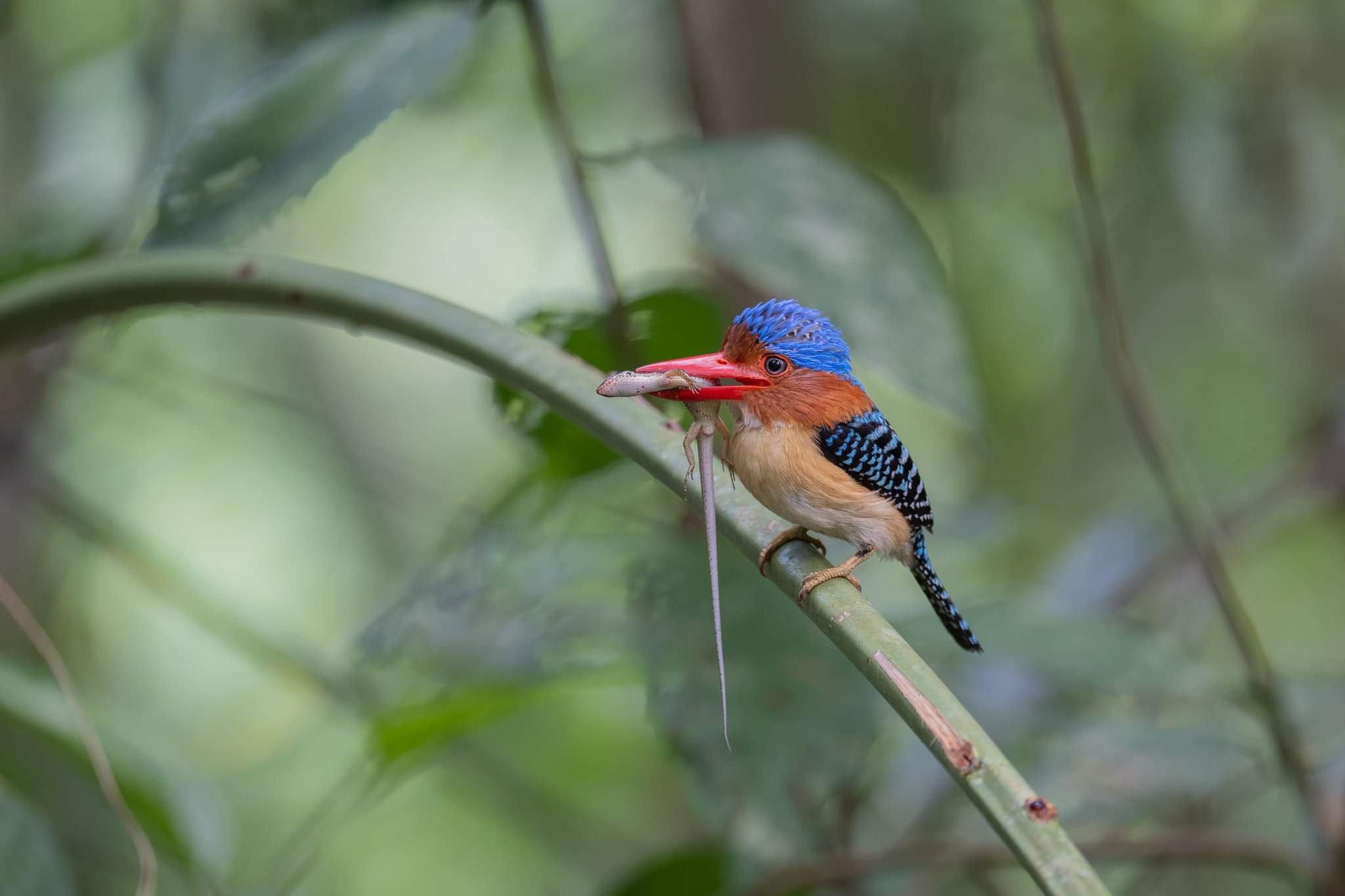
Banded Kingfisher, Thailand by Phattharadech Thananphitchayakon
Day 4: Kaeng Krachan National Park – Highlands
This morning we will leave the lodge early with a packed breakfast and we will take 4-wheel drive Jeeps straight up to the highest mountain peak of the park to km.30 and explore the Panoenthung Campground. The focus of this morning will be Ratchet-tailed Treepie, a localised endemic found only on this mountain peak. We will then slowly be birding our way down to km27. Aside from the Treepie, we will be looking for many other species such as Great Hornbill, Collared Babbler, White-browed Scimitar-babbler, Great Barbet, Blue-throated Barbet, Greater Green Leafbird, Banded Kingfisher, Lesser Racket-tailed Drongo, Hair-crested Drongo, Grey Treepie, Red-headed Trogon, Flavescent Bulbul, Black-crested Bulbul, Mountain Bulbul, White-browed Shrike-babbler, Verditer Flycatcher, Dark-sided Flycatcher, Rufous-browed Flycatcher, Black-winged Cuckoo-shrike, Long-tailed Broadbill, Orange-bellied Flowerpecker, Streaked Spiderhunter, Rufous-fronted Babbler, Yellow-bellied Babbler, White-rumped Shama and many more. Depending on how successful we have been, we may return to explore another area within the higher altitude during the afternoon, or we may visit another nearby site. Overnight at Baan Maka Nature Lodge
Day 5: Kaeng Krachan National Park – Lowlands
After breakfast we will head back into the park again, but today our focus will be on birding the lowland section of the park. We will be birding along side the road here as this can be very productive for many species and it should be an enjoyable morning with many new species. We will look Oriental Pied Hornbill, Great Hornbill, Tickell’s Brown Hornbill, Crested Serpent Eagle, Black-thighed Falconet, Greater Flameback, Greater Yellownape, Great Slaty Woodpecker, Greater Racket-tailed Drongo, Bronzed Drongo, Ashy Drongo, Asian Barred Owlet, Dollarbird, Indochinese Roller, Sultan Tit, Black-and-Red Broadbill, Black-and-Yellow Broadbill, Banded Broadbill, Silver-breasted Broadbill, Orange-headed Trogon, Golden-crested Myna, Hill Myna, Black-crested Bulbul, Black-headed Bulbul, Stripe-throated Bulbul, Ochraceous Bulbul, Vernal Hanging-parrot, Blue-winged Leafbird, Great Iora, Blue-eared Barbet, Green-eared Barbet, Coppersmith Barbet, Blue-bearded Bee-eater, Chestnut-headed Bee-eater, Asian Fairy Bluebird, Common Flameback, Crimson Sunbird, Ruby-cheeked Sunbird and many more.
After lunch, we will spend our time in a bird hide outside the park where we can see a number of new species for the trip. Birds that can be seen from the hide include Green-legged Partridge, Bar-backed Partridge, Ferruginous Partridge, Grey Peacock-pheasant, Blue Pitta, White-crested Laughingthrush, Lesser Necklaced Laughingthrush, Greater Necklaced Laughingthrush, Emerald Dove, Racket-tailed Treepie, Siberian Blue Robin, Puff-throated Babbler, Brown-cheeked Fulvetta, Black-naped Monarch, Hill Blue Flycatcher, Indochinese Blue Flycatcher, Black-crested Bulbul, Black-headed Bulbul, Stripe-throated Bulbul and more. Overnight at Baan Maka Nature Lodge
Day 6 : Kaeng Krachan National Park to Khao Yai NP via Bangkok
Our final morning in Kaeng Krachan will be spent looking for species that we may have missed or there will be time to re-visit the bird hides. After lunch we will take the drive to Khao Yai NP where we will arrive by the early evening. Overnight just outside Khao Yai NP
Day 7: Khao Yai National Park
This morning we head to the top mountain peak of the park and search for two of the most wanted birds of Khao Yai; the elegant Silver Pheasant and Thailand’s national bird, the Siamese Fireback. Hopefully, after success with the two Pheasants, we will then do some birding along a boardwalk in the same area. We will then slowly bird along the road from the higher elevation to the lower areas where we should see a diverse number of species with many key birds! We will be looking for many impressive looking species that include Red-headed Trogon, Orange-breasted Trogon, Banded Kingfisher, Common Green Magpie, Oriental Pied Hornbill, Great Hornbill, Blue-bearded Bee-eater, Long-tailed Broadbill, Silver-breasted Broadbill, Black Eagle, Red Junglefowl, Green-billed Malkoha, Hill Blue Flycatcher, Mountain Bulbul, Ashy Bulbul, Black-crested Bulbul, Puff-throated Bulbul, Grey-eyed Bulbul, Black-headed Bulbul, Common Iora, White-browed Scimitar-babbler, White-crested Laughingthrush, Black-throated Laughingthrush, Heart-spotted Woodpecker, Blue Whistling-thrush, Orange-headed Thrush, Thick-billed Green Pigeon, Mountain Imperial Pigeon, Brown-backed Needletail, Hair-crested Drongo, Greater Racket-tailed Drongo, Ashy Drongo, Black-winged Cuckoo-shrike, Scarlet Minivet, Ashy Minivet, Red-wattled Lapwing, Ashy Wood-swallow, Indochinese Roller, Crested Serpent Eagle, Grey Wagtail, Blue Rock Thrush, White-rumped Shama, Verditer Flycatcher, Taiga Flycatcher, Grey-headed Canary Flycatcher, Brown Shrike, Olive-backed Sunbird, Spotted Dove, Zebra Dove and many more.
Overnight just outside Khao Yai NP
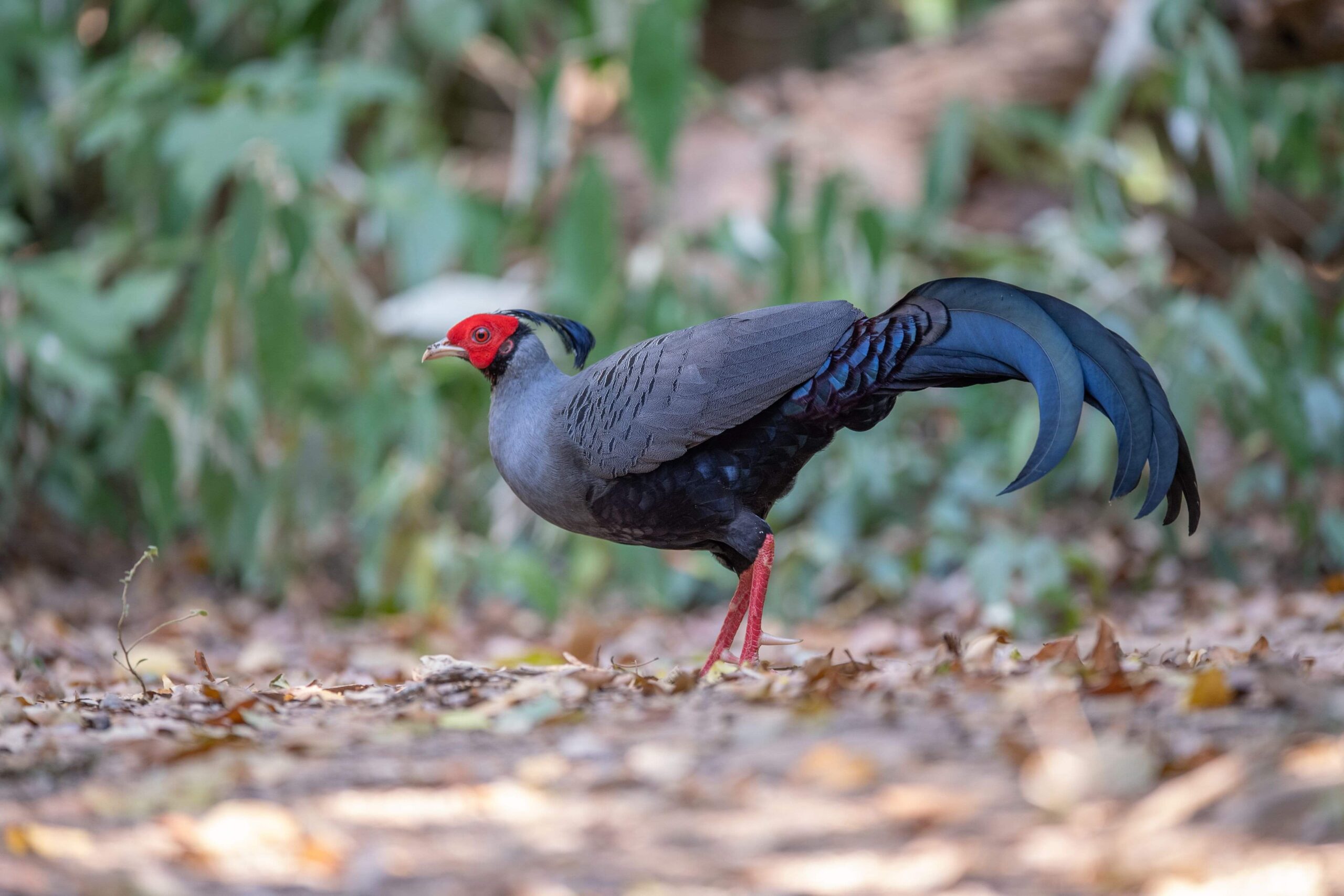
Siamese Fireback, Thailand by Phattharadech Thananphitchayakon
Day 8: Khao Yai National Park
Another full day in the park and we will again focus our time on finding new species. Wreathed Hornbill, Austen’s Brown Hornbill, Sultan Tit, Green-eared Barbet, Blue-throated Barbet, Blue-eared Barbet, Coppersmith Barbet, Chestnut-headed Bee-eater, Golden-fronted Leafbird, Blue-winged Leafbird, Sulphur-breasted Warbler, Pin-striped Tit Babbler, Yellow-vented Flowerpecker, Cambodian Flowerpecker, Black-naped Oriole, Greater Flameback, Asian Fairy Bluebird, Paddyfield Pipit, Olive-backed Pipit, Vernal Hanging-parrot, Red-breasted Parakeet, Bar-winged Flycatcher-shrike and many more. If by the afternoon, we are still missing some of our main target species, we have the option of travelling to another forest reserve near Khao Yai NP, but we will keep it flexible, as Khao Yai NP has so much to offer! Overnight just outside Khao Yai NP
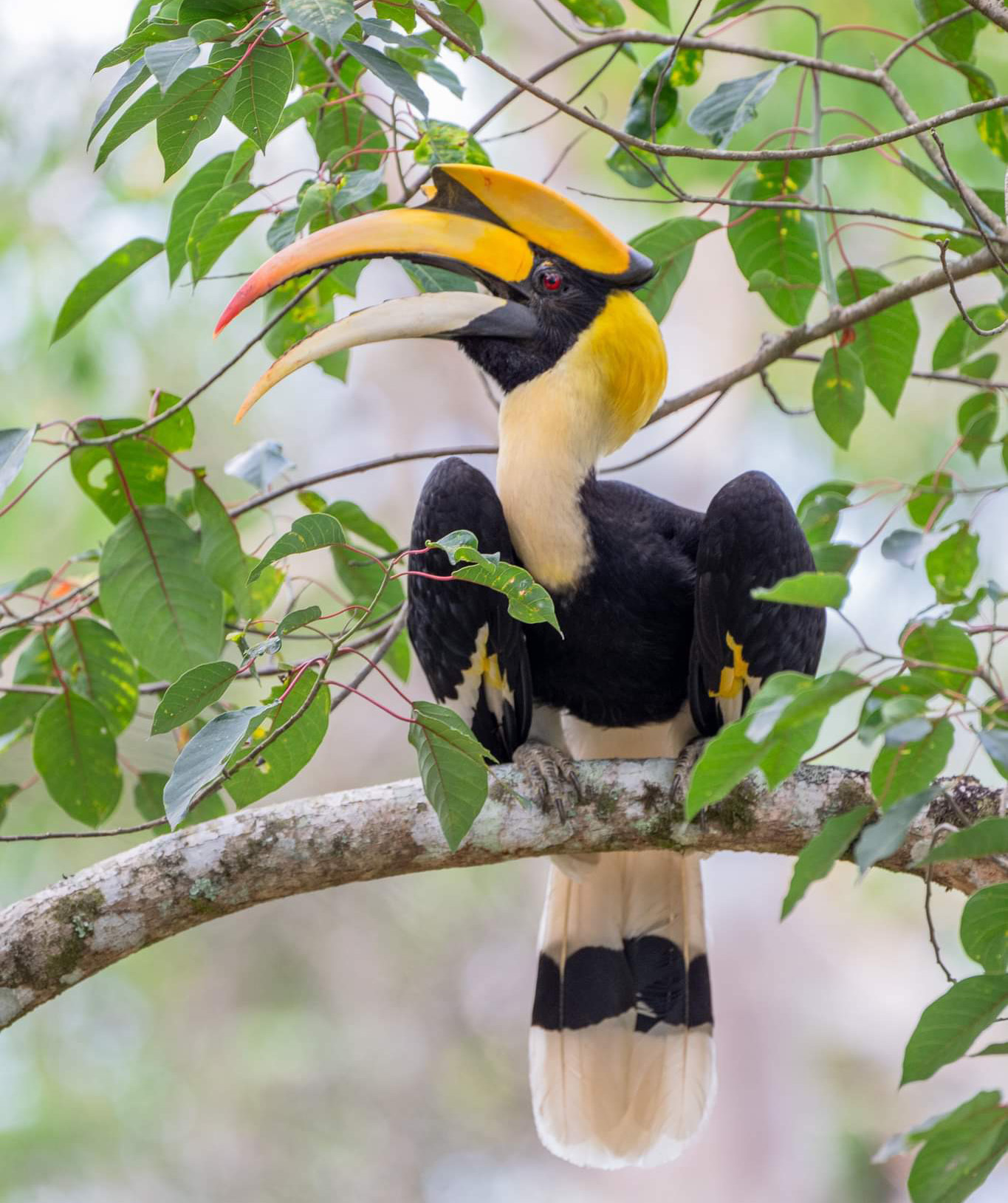
Great Hornbill, Thailand by Phattharadech Thananphitchayakon
Day 9: Saraburi Limestone Kast Forest to Nakorn Sawan Province
This morning we head off to visit the limestone mountains in Saraburi Province specifically to see the Rufous Limestone Babbler and a bird that is endemic to central Thailand restricted to the limestone karst forests of Saraburi Province. After Limestone Babbler was split into three different species, Thailand became the only country to possess populations of all three. Of course, there will be plenty of other more common birds to distract us here too.
Later in the morning we will travel to the Nakorn Sawan Province and should arrive by the mid afternoon. We will first check into our hotel and then visit a small wetland not far from the hotel where we should find a good selection of birds such as White-breasted Waterhen, Little Pratincole, Asian Openbill, Yellow Bittern, Cinnamon Bittern, Chestnut-capped Babbler, Plain Prinia, Scaly-breasted Munia, White-rumped Munia, Chestnut Munia, Streak-eared Bulbul, Yellow-vented Bulbul, Malaysian Pied Fantail, White-breasted Kingfisher, Taiga Flycatcher, Asian Brown Flycatcher, Hainan Blue Flycatcher and more. Overnight Mai Hom Resort Hotel, Ban Kluai
Day 10: Bung Boraphet Lake to Chiang Mai Province
This morning we visit Bung Boraphet Lake where we will take a boat trip for the morning. It should be a great way to spend a nice relaxed morning birding and to boost our bird list with a good selection of waterbirds, species such as Lesser Whistling Duck, Cotton Pygmy Goose, Little Grebe, Glossy Ibis, Black-headed Ibis, Oriental Darter, Striated Grassbird, Pheasant-tailed Jacana, Bronze-winged Jacana, Grey-headed Swamphen, White-browed Crake, White-breasted Waterhen, Pin-tailed Snipe, Red-wattled Lapwing, Pacific Golden Plover, White-breasted Kingfisher, Black-capped Kingfisher, Common Kingfisher, Plaintive Cuckoo, Asian Koel, Greater Coucal, Asian Golden Weaver, Baya Weaver, Amur Stonechat, Eastern Marsh Harrier, Pied Harrier, and more. After the boat trip , we will spend a bit of time near the pier and check the reed edge for species such as Chestnut-capped Babbler, Yellow-bellied Prinia, Oriental Reed-warbler, Thick-billed Reed-warbler, Black-browed Reed-warbler, Lanceolated Warbler and more.
After our lunch, the rest of the day will be spent travelling as we take the long journey of around 6.5 hours to Chiang Mai. Overnight Sakulchai Place Hotel, Chiang Mai
Day 11: Tham Pha Plong Temple and rice paddies in Fang district
We will leave early and head for Tham Pha Plong Temple, located at the foothill of the huge limestone mountain of Doi Chiang Dao. During the walk up to the temple we will be looking for many new species. The list is exciting here and we hope to find species such as Orange-breasted Trogon, Pin-tailed Green-pigeon, Thick-billed Green-pigeon, Annam Limestone Babbler, Black-hooded Oriole, Greater Racket-tailed Drongo, Hair-crested Drongo, Asian Fairy Bluebird, Red-whiskered Bulbul, Black-crested Bulbul, Sooty-headed Bulbul, Black Bulbul, White-headed Bulbul, White-crested Laughingthrush, Greater Necklaced Laughingthrush, Lesser Necklaced Laughingthrush, Green-billed Malkoha, White-rumped Shama, Verditer Flycatcher, Grey-headed Canary Flycatcher, Blue Rock Thrush, Puff-throated Babbler, Pin-striped Tit Babbler and many more.
After lunch we will head to our hotel in Fang district and then later in the afternoon we can visit some nearby rice paddies for some general easy birding. Birds we might see in this habitat include Amur Stonechat, Pied Bushchat, Little Green Bee-eater, Brown Shrike, Long-tailed Shrike, Scaly-breasted Munia, White-throated Kingfisher, Paddyfield Pipit, Ashy Wood-swallow, Asian Pied Starling, Black-collared Starling, Great Myna, Common Myna, Oriental Magpie Robin, Chinese Pond Heron etc. Overnight Tangerine Ville Hotel, Fang District
Day 12: Doi Ang Khang
This morning we will travel up the mountain to Doi Ang Khang. This birding site is on the border with Myanmar consisting of a number of peaks and steep ridges that, although largely deforested farmland, contain a lot of scrubby vegetation and forest patches which provide enough habitat to house a good number of interesting bird species, many of which are found in few other parts of the country. One of the delights of Doi Ang Kang is that the scenery is some of the most spectacular in the country and the weather is often cooler than in the lowlands. We will spend the morning birding the mountain looking for key species such as Giant Nuthatch, Chestnut-vented Nuthatch, Crested Finchbill, Flavescent Bulbul, Brown-breasted Bulbul, Striated Bulbul, White-headed Bulbul, Dark-backed Sibia, Rufous-backed Sibia, Grey-capped Woodpecker, Stripe-breasted Woodpecker, White-browed Shrike-babbler, Burmese Shrike, Long-tailed Shrike, White-browed Scimitar-babbler, Silver-eared Mesia, Maroon Oriole, Black-hooded Oriole, Ashy Drongo, Scarlet Minivet, Long-tailed Minivet, Short-billed Minivet, Cook Swift, Japanese Tit, Black-winged Cuckoo-shrike and many more.
In the afternoon we will visit a botanical garden where we will look for Spot-winged Grosbeak, Gould’s Sunbird, Black-throated Sunbird, Green-tailed Sunbird, Streaked Spiderhunter, Annam Limestone Babbler, Yunnan Fulvetta, Blue-winged Minla, Black-breasted Thrush, Chestnut-thrush, Grey-winged Blackbird, White’s Thrush, Dark-sided Thrush, and several species of White-eye. Overnight Tangerine Ville Hotel, Fang District
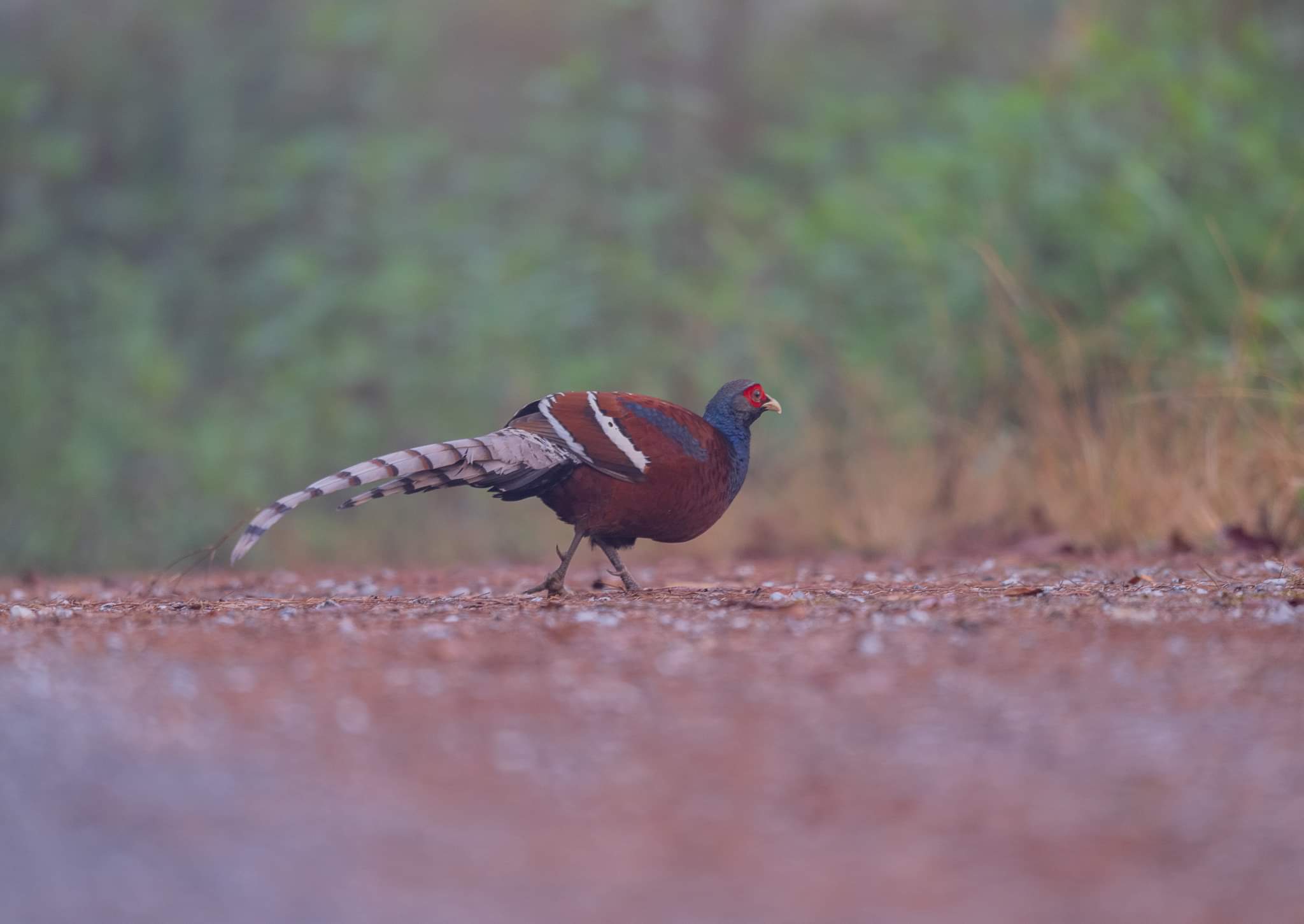
Mrs Humes Pheasant, Thailand by Phattharadech Thananphitchayakon
Day 13: Doi San Ju
Today we will depart very early at 4.30 am. so we can get ourselves in position at a feeding site and portable bird hide on Doi San Ju, ready for sunrise. This spot is the easiest place in Thailand to see Mrs Hume’s Pheasant (one of the world’s rarest Pheasant) at point-blank range. Other species often occurring at this spot are Mountain Bamboo Partridge, White-browed Laughingthrush, Rusty-cheeked Scimitar-babbler, Giant Nuthatch, Chestnut-vented Nuthatch, Ultramarine Flycatcher, Rufous-gorgetted Flycatcher, Olive-backed Pipit, Grey Bushchat, and Long-tailed Shrike. We will spend around 2-3 hours at the feeding area before birding slowly along the road. Key birds that we will be looking for today include Himalayan Cutia, Spot-breasted Parrotbill, Scarlet-faced Liocichla, Rufous-bellied Niltava, Large Niltava, White-bellied Redstart, Siberian Rubythroat, Black-throated Bush Tit, Chestnut-bellied Rock-thrush, Blue Whistling-thrush, White-browed Shrike Babbler, Yunnan Fulvetta, Golden Babbler, Golden-throated Barbet, Hume’s Treecreeper, Grey Treepie, Slaty-blue Flycatcher, Hill Prinia, Lesser Yellownape, Long-tailed Broadbill and many more. Overnight Tangerine Ville Hotel, Fang District
Days 14: Fang Hot Spring and to Doi Inthanon National Park
Today we visit one of the most famous tourists attractions in Fang district and is a very pleasant setting for some general birding, but the undoubted highlight for birders visiting is the flock of Spot-winged Grosbeaks that regularly spend the “winter” months here. It is also a good place for rarities as the warmth of the hot Springs can attract regional and altitudinal migrants. A walk around the hot springs and a stream nearby can produce species such as Asian Barred Owlet, Spot-winged Grosbeak, Coppersmith Barbet, Lineated Barbet, the white-faced race of Eurasian Jay, Ashy Minivet, Scarlet Minivet, Rosey Minivet, Grey Bushchat, Black-crested Bulbul, Black-headed Bulbul, Stripe-throated Bulbul, White-capped Water-redstart, Blue-bearded Bee-eater, Greater Coucal, Black-hooded Oriole, Black-naped Oriole, Greater Racket-tailed Drongo, Black-winged Cuckooshrike, Green-billed Malkoha, Barn Swallow, Striated Swallow, White-crested Laughingthrush, White-rumped Shama, Blue Rock-thrush, Blue Whistling-thrush, Little Pied Flycatcher, Hume’s White-eye, Chestnut-flanked White-eye, Oriental Honey Buzzard and many more.
We will then return to our hotel during the late morning, collect our luggage and travel to Doi Inthanon National Park. The journey is around 4.5 hours and if we arrive before sunset, we will check the lower elevation area inside the park where the Dry dipterocarp forest occurs and she will look for Collared Falconet, Black-headed Woodpecker, Lineated Barbet, Red-billed Blue Magpie, Sooty-headed Bulbul, and White-rumped Falcon. Overnight Mr Daeng Bird Centre Resort
Day 15: Doi Inthanon National Park
This morning we will travel straight up to the top mountain peak of the park and the the highest mountain in Thailand at 2,565 meters above sea level. The habitat at this high altitude is a unique peat bog surrounded by pristine cloud forest and the only habitat type in the country. We will spend the morning birding on a well-maintain boardwalk through the peat bog in a loop. A few hours birding from this boardwalk and the near area can produce some of the most exciting birding in the country and the bird list is endless! We will be looking for many species which include Doi Inthanon Sunbird (endemic sub-species), Gould’s Sunbird, Ashy-throated Warbler (endemic species), White-browed Shortwing, Snowy-browed Flycatcher, Slaty-bellied Tesia, Pygmy Cupwing, Rufous-throated Partridge, Dark-sided Thrush, Yellow-bellied Fairy Fantail, Yellow-bellied Flowerpecker, Davison’s Leaf Warbler, Rufous-winged Fulvetta, Silver-eared Laughingthrush, Dark-backed Sibia, Chestnut-tailed Minla, Blue-winged Minla, Eye-browed Thrush, Grey-sided Thrush, Speckled Wood Pigeon and Ashy Wood Pigeon.
As we slowly bird our way down to the mid-elevation area we will be looking for other new species such as Slaty-bellied Tesia, Lesser Shortwing, White-gorgetted Flycatcher, Hume’s Treecreeper, White-throated Fantail, Yellow-bellied Fairy-fantail, Black-eared Shrike-babbler, Clicking Shrike-babbler, Mountain Bulbul, and Lesser Racket-tailed Drongo.
After lunch, we will visit a stream near an electricity power generation station and visit a nearby waterfall for species like White-capped Water-redstart, Plumbeous Redstart, Pygmy Cupwing, Streaked Wren-babbler, White-crowned Forktail, Slaty-backed Forktail and more. Overnight Mr Daeng Bird Centre Resort
Day 16: Doi Inthanon National Park and transfer to Airport
We will spend our last morning looking for more new species around the park’s second checkpoint. Here we can stroll along the road and also take a short forest trail. Species we will look for include Long-tailed Minivet, Short-billed Minivet, Grey-chinned Minivet, Little Pied Flycatcher, Mountain Tailorbird, Yellow-cheecked Tit, Rufous-backed Sibia, Chestnut-crowned Warbler and more. After lunch we will take the 90 minute drive to Chiang Mai airport for a flight to Bangkok and back to the UK.
Please note this is a flexible itinerary which may need to be adjusted slightly dependent on arrival / departure times, weather conditions and the most recent information from our local guides
Leaders: Wise Birding leader and local guide throughout
Included in cost: Accommodation in twin en-suite rooms, all meals starting with breakfast on day 2 to lunch on day 15, bottled water, ground transport, boat trips, park and reserve fees and services of leader.
Not included in cost: International flight and domestic flight from Chiang Mai, travel insurance, drinks other than water and any airport/visa fees.
Single Supplement: £300
Transport: Minibus and Jeeps in some areas.
Difficulty: A good level of fitness is required, particularly when walking on some trails covering a range of altitudes. Optional steeper trails in places, but birding from open trails otherwise.
Climate: Central Region is hot and humid in the lowlands and cooler in the mountains. The North region is generally cold in the mornings and more humid at the mid/lower elevations. Rain is possible in both regions.
Tour Start Point: Bangkok International airport, Thailand
Tour End Point: Chiang Mai airport, Thailand
Suggested Airlines: Lufthansa via Munich